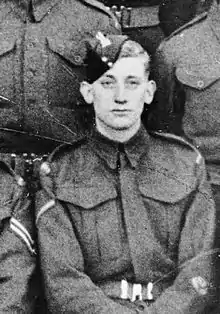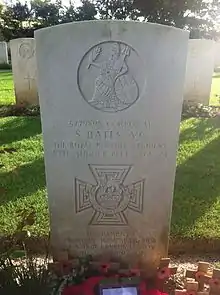Sidney Bates | |
|---|---|
 | |
| Nickname(s) | "Basher"[1] |
| Born | 14 June 1921 Camberwell, London, England |
| Died | 8 August 1944 (aged 23) Sourdeval, German-occupied France |
| Buried | Bayeux War Cemetery, Calvados, France |
| Allegiance | United Kingdom |
| Service/ | British Army |
| Years of service | 1940–1944 † |
| Rank | Corporal |
| Service number | 5779898 |
| Unit | Royal Norfolk Regiment |
| Battles/wars | World War II (DOW) |
| Awards | Victoria Cross |
Corporal Sidney Bates VC (14 June 1921 – 8 August 1944) was a British recipient of the Victoria Cross, the highest and most prestigious award for gallantry in the face of the enemy that can be awarded to British and Commonwealth forces.
Early life
Sidney Bates was born in Camberwell, London on 14 June 1921 to Frederick, a rag and bone man, and Gladys May Bates. At the outbreak of World War II , Bates was working as a carpenter's labourer. He joined the British Army and served with the 1st Battalion of the Royal Norfolk Regiment in June 1940 shortly after it returned from being stationed in Delhi, British India. By 1944, the battalion was part of the 185th Infantry Brigade, itself one of three brigades forming part of the 3rd Infantry Division. The battalion landed in Normandy on 6 June 1944 as part of Operation Overlord.

Military service
Bates was 23 years old, and a corporal in the 1st Battalion, Royal Norfolk Regiment, British Army during the Second World War, when the following deed took place for which he was awarded the Victoria Cross.
On 6 August 1944 near Viessoix, (see ambiguity concerning 'Sourdeval' below) France, Bates was commanding a section. Upon discovering that the enemy had penetrated deeply in the area occupied by his section, Bates seized a light machine-gun and charged, moving forward through a hail of bullets. Although twice wounded, he was undaunted and continued firing until the enemy started to withdraw from his fire. At that moment he was wounded for a third time — mortally. He still however continued to fire until his strength failed him. By this time the enemy had withdrawn and the situation had been restored, and the immediate threat to his platoon subsided. He died in hospital two days later.
The Norfolks' position was under attack by the 10th SS Panzer Division. The final costs of fighting around Sourdeval for the Norfolks was 160 casualties out of 550. The recommendation for the award was made by Major Cooper-Key, the commanding officer of B Company of the 1st Battalion. The recommendation was turned down initially but Cooper-Key persevered. According to Sergeant George Smith the battalion had been on the march when they had come under fire. A Bren gunner had been killed next to Corporal Bates, who had immediately seized the machine gun and started firing on the enemy.
Victoria Cross citation
The announcement and accompanying citation for the decoration was published in supplement to the London Gazette on 2 November 1945, reading[2]
'War Office, 2nd November, 1944.
Headstone in the Bayeux Commonwealth Grave CemeteryThe KING has been graciously pleased to approve the posthumous awards of the VICTORIA CROSS to:—
No. 5779898 Corporal Sidney Bates, The-Royal Norfolk Regiment (London, S.E.5).
In North-West Europe on 6th August, 1944, the position held by a battalion of the Royal Norfolk Regiment near Sourdeval was attacked in strength by 10th S.S. Panzer Division. The attack started with a heavy and accurate artillery and mortar programme on the position which the enemy had, by this time, pin-pointed. Half an hour later the main attack developed and heavy machine-gun and mortar fire was concentrated on the point of junction of the two forward companies. Corporal Bates was commanding the right forward section of the left forward company which suffered some, casualties, so he decided to move the remnants of his section to an alternative position whence he appreciated he could better counter the enemy thrust. However, the enemy wedge grew still deeper, until there were about 50 to 60 Germans, supported by machine guns and mortars, in the area occupied by the section.
Seeing that the situation was becoming desperate, Corporal Bates then seized a light machine-gun and charged the enemy, moving forward through a hail of bullets and splinters and firing the gun from his hip. He was almost immediately wounded by machine-gun fire and fell to the ground, but recovered himself quickly, got up and continued advancing towards the enemy, spraying bullets from his gun as he went. His action by now was having an effect on the enemy riflemen and machine gunners but mortar bombs continued to fall all around him.
He was then hit for the second time and much more seriously and painfully wounded. However, undaunted, he staggered once more to his feet and continued towards the enemy who were now seemingly nonplussed by their inability to check him. His constant firing continued until the enemy started to withdraw before him. At this moment, he was hit for the third time by mortar bomb splinters, a wound that was to prove mortal. He again fell to the ground but continued to fire his weapon until his strength failed him. This was not, however, until the enemy had withdrawn and the situation in this locality had been restored.
Corporal Bates died shortly afterwards of the wounds he had received, but, by his supreme gallantry and self sacrifice he had personally restored what had been a critical situation.[3]
His Victoria Cross is displayed at The Royal Norfolk Regiment Museum, Norwich, England. The museum trustees purchased it for £20,000 in the 1980s. His was one of five VCs won by members of the Royal Norfolk Regiment during the Second World War.
Although the VC citation gives the hamlet Sourdeval as the location (not to be confused with the market town of Sourdeval about 20 km (12 mi) away), it is actually at Pavée. There is a fitting memorial to Bates at Pavée.
Grave
The grave of Sidney Bates can be found in the Bayeux Commonwealth War Graves Commission Cemetery, Calvados, France. (Reference 20E)[4]
References
- ↑ Forgotten Voices Of The Victoria Cross, Roderick Bailey - Page 262
- ↑ "Bayeux War Cemetery". Archived from the original on 23 June 2013. Retrieved 30 August 2012.
- ↑ "No. 36774". The London Gazette (Supplement). 31 October 1944. p. 5016.
- ↑ CWGC entry
Bibliography
- John, Laffin (1997). British VCs of World War 2: A Study in Heroism. Sutton Publishing. ISBN 0-7509-1026-7.
- Buzzell, Nora, ed. (1997). The Register of the Victoria Cross. Cheltenham, Gloucestershire: This England Alma House. ISBN 0-906324-27-0.
- Monuments to Courage (David Harvey, 1999)
